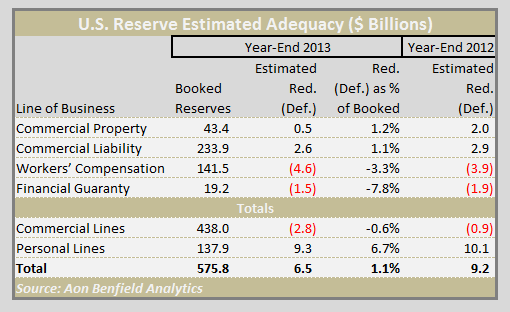According to an analysis published by Aon Benfield, loss reserves held by U.S. property/casualty insurers for commercial lines are deficient by $2.8 billion, with workers compensation coming in almost $5 billion deficient at year-end 2013.
Aon Benfield put the estimated deficiency for workers comp at $4.6 billion. But reserve positions for other commercial lines, including commercial property and liability, were redundant as of Dec. 31, 2013, bringing the overall deficiency to the $2.8 billion figure.
The overall figure, however, represented a deterioration from a $0.9 billion deficiency as of Dec. 31, 2012, according to Aon Benfield’s calculations.
Still, the year-end 2013 deficiency represents less than 1.0 percent of booked reserves for commercial lines.
The study, compiled by Aon Benfield Analytics, indicates that personal lines shows a redundancy at the end of both 2013 and 2012. But it was not as strong in 2013 as in 2012, with the redundancy level slimming to $9.3 billion at year-end 2013 compared to $10.1 billion at year-end 2012.
Adding everything up, the total industry reserve position is $6.5 billion redundant for year-end 2013.
The study also reports that $14.8 billion of reserves relating to losses incurred in prior years were released during calendar-year 2013.
“At the current average run rate, the [industry’s overall] redundancy should be eliminated within half a year,” the report said.
Using data from SNL Financial, members of the Aon Benfield Analytics team report that overall reserve releases—for commercial and personal lines together—were higher in calendar-year 2013 than in the prior two calendar years. Specifically, the $14.8 billion takedown figure for 2013 compares to $12.2 billion for 2012 and $12.7 billion for 2011.
In a statement about the report, Brian Alvers, chief actuary for Aon Benfield Americas, said: “It was a surprise to see more reserves released in 2013 as compared to 2011 and 2012, but the prior accident years continue to produce favorable reserve takedowns from the positive claims environment at the time.”
The Aon Benfield study examines U.S. statutory Schedule P triangles to generate an overall industry position from a by-line analysis. The study is based on U.S. insurers’ ongoing statutory filings and is therefore subject to future fluctuations in its data.
The full study can be found here.






















 Truckers Who Fail English Tests Are Pulled Off Roads in Crackdown
Truckers Who Fail English Tests Are Pulled Off Roads in Crackdown  Unpacking a Consumer Intervenor’s Novel Idea
Unpacking a Consumer Intervenor’s Novel Idea  Why Insurance Telematics Integrations Fail
Why Insurance Telematics Integrations Fail  A Practical Blueprint: The Five Plays of an Innovation Culture
A Practical Blueprint: The Five Plays of an Innovation Culture 






